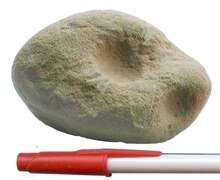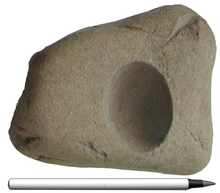Cupstone
| Cupstone, Poculolith, Pitted Cobble, Nutting stone | |
|---|---|
 A cupstone | |
| General | |
| Category | Archaeological Artifact |
Cupstones, also called anvil stones, pitted cobbles and nutting stones, among other names, are roughly
Etymology
One encyclopedia of archaeology treats "pitted stone", "cupstones", and "nutting stones" as synonyms and says that they "may have been formed by cracking nutshells, though this activity lacks adequate confirmation through ethnographic examples or published experimentation."[2]
Purpose
These objects have received little study, perhaps because edged tools and weapons have more intrinsic interest to private collectors, but closer study of them might reveal something of domestic practices and toolmaking technology. There is no agreement upon their purpose or purposes, which may have included the processing of food, medicine or pigments, storage, arrow-production or fire-drilling. As such, they could represent a primitive form of mortar and pestle. The age of these man-made structures is difficult to ascertain, but generally they are believed to have been produced in the Bronze Age and Upper Paleolithic although some, for example in North America and Europe, were generated at a later date.
Visually, they may resemble
Distribution
Similar objects can be found on all continents except Antarctica. They are associated with
The pattern, size and number of concavities is not predictable, nor is material—impressions are found in soft
Historic accounts
There are several ethnographic accounts of the Native use of nutting stones in the historic times.[4][5] One account says "the Virginia Indians in 1587 tells us that each household had stones for cracking nuts and for grinding shell and other materials." It goes on to say that "This statement would doubtless be equally true if applied at that time to almost any tribe inhabiting the section east of the Mississippi."[6]
In
Interpretation
This section needs additional citations for verification. (November 2021) |
Early observers saw the processing of mast using stones, and one later recreation achieved similar results: nuts were placed, one at a time, on stone (an "anvil" stone) and then struck with a smaller "hammer" stone: "As nuts were cracked in this manner a pit developed in the lower stone; the pit deepened as additional nuts were cracked, and this facilitated the cracking process since nuts were held rather stationary in this 'seat.'"[8]
The most likely interpretation seems that these artifacts represent a single technique of shaping or adapting stone for multiple purposes, some unguessed (for instance, the function of the smallest pits) and that the objects could be used by single or multiple individuals over long periods of time, and for various purposes. Indeed, the apparent randomness of their distribution may indicate that they were left lying as modified natural resources, whether with benevolent intent or because they did not represent a sufficient investment of time and labor to justify transporting them ("opportunistic" tools). More simply, perhaps the users intended to return to the same area during the next year's mast-gathering period.
The now traditional term "nutting stone" may be justified, as may "straightening stone" or "shaft-anchor" (for straightening arrow-shafts) within a larger class we might call "poculoliths" (<L. poculus, "small pocket", "cup"). While an equivalent to "pitted stone", the proposed term has the advantage of wider comprehensibility among international scholars as the worldwide distribution of the form becomes increasingly evident.
Another interpretation of these structures is fossilization. Anatomical structures of the orbit, skull, joints, organs, antler and dental cavities are similar. Fragmentation may have occurred before or after fossilization, natural human smoothing and polishing. The structure becomes a ubiquitous, multipurpose tool for humans to exploit.
Cupstone sites in Northern Italy, Switzerland and the Atlantic regions, also known as "druid altars" or "Opferkessel" (sacrificial bowl), are associated with places of worship due their locality close to glacial erratics, view points and treacherous alpine trails. Some of the prehistoric cupstone sites north of the Alps along the Jura mountains, for example near Grenchen, show a row of cups with possibly astronomical orientation. However, cupstones are usually not associated with calendar functions as this is sometimes the case with menhirs and megaliths.

Omars
Nutting stones can be very similar in appearance to
See also
References
- ISBN 3-932704-66-5.
- ^ George H. Odell, "Pitted Stones" in Archaeology of prehistoric native America: an encyclopedia, ed. Guy E. Gibbon and Kenneth M. Ames. (Privately printed in the United States, 1998), 652.
- ^ Dutch, S. (n.d.) Leaverites - Features in Sedimentary Rocks Archived 2009-03-27 at the Wayback Machine. Downloaded October 28, 2009
- ^ C. Allan Jones Texas roots: agriculture and rural life before the Civil War (College Station : Texas A&M University Press, 2005), 23.
- ^ Sarah H. Hill Weaving new worlds: Southeastern Cherokee women and their basketry (Chapel Hill : University of North Carolina Press, 1997), 10.
- ^ Earnest Hooton, "Indian Village Site and Cemetery Near Madisonville Ohio" in Papers of the Peabody Museum of American Archaeology and Ethnology, Harvard University, (Cambridge, MA: The Peabody Museum, 1922), 56.
- ISBN 978-0-8248-0514-2. Retrieved 14 May 2017.
- ^ Talalay, Laurie Talalay, Donald R. Keller, and Patrick J. Munson, "Hickory Nuts, Walnuts, Butternuts, And Hazelnuts: Observation and Experiments Relevant to Their Aboriginal Exploitation in Eastern North America," in Experiments and Observations on Aboriginal Wild Plant Food Utilization in Eastern North America, ed. Patrick J. Munson, (Indianapolis : Indiana Historical Society, 1984), 351.
